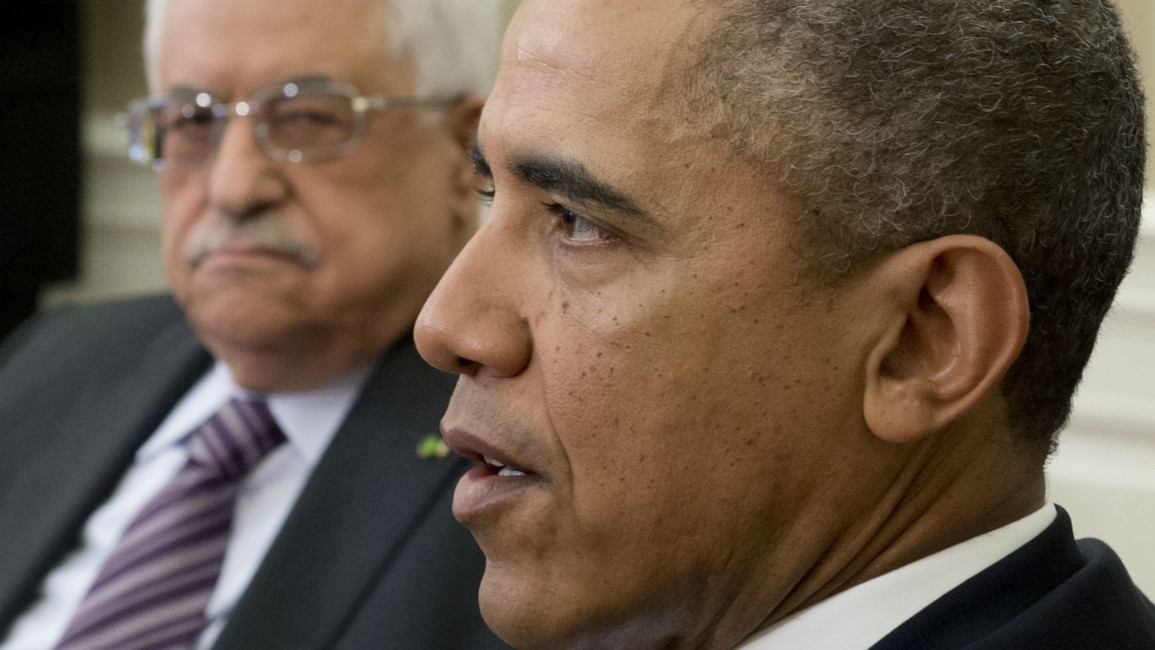What Obama 'didn't know' about Palestine is almost unfathomable
An intrepid State Department official pages through a (possibly dusty) file and discovers, in 2015, a map that would change his life forever, and radically alter his outlook on the world (well, at least on the Israeli-Palestinian part of it).
The official in question was Frank Lowenstein, Barack Obama's special envoy on Israeli-Palestinian negotiations.
The map he came upon, which helped him see "the forest for the trees", showed not only the actual Israeli settlements in the West Bank, but also all the land that was controlled by Israel and off limits to Palestinians, according to a report in The New Yorker.
Lowenstein and his team then reportedly "did the math", drew up a series of larger maps and calculated that Israel had gobbled up 60 percent of the West Bank, territory that had been earmarked for a future Palestinian state, and that the areas Israel controlled cut off Palestinian population centres from one another. The revelation apparently shocked Obama and John Kerry, then secretary of state and peace envoy.
The New Yorker article shocked me too - albeit for very different reasons. It shocked me because I could scarcely comprehend or credit that the Obama administration was unaware of what, to anyone with knowledge of the topic or who had spent some time on the ground, was very familiar terrain.
 |
The map showed not only the actual Israeli settlements in the West Bank, but also all the land that was controlled by Israel and off limits to Palestinians |  |
In light of his career path and his then recent recruitment as special envoy, it is conceivable that Lowenstein was unaware of these facts, although the so-called Area C of the West Bank, which is under complete Israeli control and represents 60 percent of the West Bank, is one of the most basic of basics of the conflict.
But the idea that the rest of the team, especially John Kerry, who had been shuttling back and forth trying to broker a deal since 2013, found any of this to be news was almost unfathomable. This is especially true in light of the fact that the Palestinian negotiating team resigned, in November 2013, because they argued that Israel's ongoing and accelerating settlement activity had rendered it impossible to establish a viable Palestinian state.
Read more: Ireland parliament to vote on banning Israeli illegal settlement goods
Had I known back then that the Obama administration was so reportedly clueless of the extent of the Israeli settlement enterprise, I would have applied for the position of Middle East adviser myself. That is not because I am especially qualified, but because the Obama administration was so self-admittedly ignorant.
For example, I could have directed Lowenstein and his team not just to the single map he came across, but an entire atlas and databases, produced by the UN, mapping out pretty much every conceivable aspect of the Israeli occupation and settlements project in East Jerusalem and the West Bank, including settlements, restrictions and closures, access to water and land, as well as demolitions and communities at risk.
Twitter Post
|
Palestinian, international and Israeli NGOs, not to mention academics and think tanks, also carry out extensive research on these issues, making the Israeli-Palestinian conflict one of the most researched in the world.
For instance, Israeli NGO B'Tselem has published information on settlements for years that would have made for painful reading for Lowenstein and the rest of the team.
Statistics and reports, no matter how good, cannot capture reality quite like seeing the reality on the ground for oneself. Had I had access to the Obama team, I would have simply invited them round to the apartment we used to rent in East Jerusalem.
Located on the Mount of Olives, our front terrace overlooked the breathtaking beauty of the Jordan Valley, all the way down to the Dead Sea and beyond, into Jordan.
Underneath the magnificence of the natural landscape one could also trace many of the topographical features of the occupation, including settlements and outposts, the Israeli wall, the gleaming modern highways snaking between the settlements, the meandering, ill-maintained roads reserved for West Bank Palestinians and the densely populated Palestinian towns unable to access and grow into the surrounding Area C.
This land is defined variously by Israel as
'restricted military areas', 'state land' or 'nature reserves', anything to keep it out of the reach of the Palestinians.
I would point to the nearby Palestinian town of Ezeriya, only a couple of kilometres away as the crow flies and home to what is believed to be the tomb of Lazarus, where Jesus is said to have wept before resurrecting his dead follower.
In the past, the tomb and the surrounding town were a short and pleasant hike from where I lived. However, when I lived there, owing to the wall and various movement restrictions, it required a 20km or so drive to reach it.
In fact, driving is one of the simplest ways to navigate the reality of the occupation and clearly witness just how much the road to two states has been bulldozed and obliterated, and how the so-called road map to peace leads to nowhere.
In fact, even satellite navigation cannot decipher the complexity of the rapidly changing political reality on the ground, as demonstrated by the number of times my GPS sent me to a shuttered gate, road block, or restricted military area.
 |
The revelation apparently shocked Obama and John Kerry, then secretary of state and peace envoy |  |
On the road, I would have driven Lowenstein and his team to view and contrast the settlements, with Palestinian villages and towns. I'd have taken them to visit vulnerable and threatened communities in Area C, such as the recently evicted Bedouin village of Khan al-Ahmar, or to the temporary camps set up by activists protesting the attempts to join settlements in a continuous seam.
And even if the Obama team did not have time to undertake such time-consuming field work, all they needed to do was listen to Israel's ultra-nationalist, right wing government, which made no secret of its support of the settlement enterprise and its determination to render the prospect of a Palestinian state an impossibility.
Some time before Lowenstein's eureka moment, Likud and Jewish Home members of the Knesset tried to push a bill through to annex Israeli settlements, thereby rendering much of Area C permanently beyond Palestinian reach. Many on the right believe the entire West Bank is and should be Israel's.
Deputy Foreign Minister Tzipi Hotovely is a vocal member of this camp: Not only does she oppose Palestinian statehood, she also urged Israeli diplomats that "this country is all ours. We didn't come here to apologise for that."
Netanyahu has been ideologically opposed to the creation of a Palestinian state for decades. He vociferously opposed and vilified Yitzhak Rabin for forging the Oslo accords, which were also violently opposed by Hamas and Islamic jihad suicide bombers, and actively worked to destroy it when he was first elected prime minister in 1996. During his re-election campaign in 2015, he promised the electorate there would be no Palestinian state on his watch.
 |
If the Obama administration was ignorant of this staggering body of publicly available evidence, it suggests a monumental level of incompetence |  |
If the Obama administration was ignorant of this staggering body of publicly available evidence, it suggests a monumental level of incompetence.
However, I suspect there is another explanation which makes more sense: Obama and Kerry did not possess the imagination, courage and political capital to adopt new and more effective approaches to the conflict, and, like previous administrations, they did not have the guts to admit publicly from the beginning what has been clear since the mid-1990s: That the Oslo blueprint for peace was dead in the water almost as soon as it was floated.
After all, it is easier to plead ignorance than admit to spinelessness.
Khaled Diab is a journalist and writer who is currently based in Tunisia. He is the author of two books: Islam for the Politically Incorrect (2017) and Intimate Enemies (2014).
Follow him on Twitter: @DiabolicalIdea
Opinions expressed in this article remain those of the author and do not necessarily represent those of The New Arab, its editorial board or staff.



